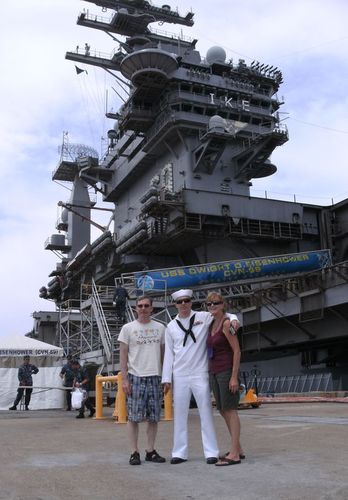Travel Article
Travel Article
Cruisin' on a Carrier
By Ron Bolt
"Go big or stay home." That's what Carol and I thought when selecting our latest cruise ship.
Did we go big? How about a cruise aboard a working nuclear powered aircraft carrier?
So how did we pull that off?
Our son Brett's Carrier Strike Group returned from a six-month deployment in the Mediterranean Sea and Persian Gulf. The Eisenhower made its first US stop near Jacksonville, Florida where 1000 of the 5000 crew exited the ship.
The Navy plans for these early exits on long deployments and invites family and friends of the remaining crew to come aboard for a 3-day Tiger Cruise on the last leg of the journey.
Don't get the idea we enjoyed a life of luxury and pampering on this cruise. The Eisenhower was a working ship and we needed to stay out of the way of speeding fork lifts, fighter jets moving around in the hanger bay and massive elevators. These elevators appeared to be part of the deck until they raised or lowered aircraft or cargo.
Elevators for crew or tigers? Ha! Going from one deck to another required negotiating steep steps through hatches or ladders through scuttles. We constantly unsealed and resealed hatches between air-locked passageways when moving through.
The Navy designs these carriers like bewildering mazes. Carol and I wandered around when our son worked. The Navy removed maps from walls so tigers could not find sensitive places. We got hopelessly lost a number of times. Sailors told us to follow them because attempting to give directions would have been an exercise in futility. Our son laughed when we told him of becoming lost so badly in one particular maze that we would have eventually died there. "Deck 3?" he guessed "We don't even try to find our way through there."
I slept in berthing 2-62-2-L and my wife slept in female berthing 01-247-1-L. I won't even attempt to explain the room numbers, but if you know someone who spent time in the Navy, he or she will delight in decoding them for you.
Racks three high packed the berthings. One needed to slide into and out of the racks because there's only about two feet of vertical space. Carol needed to climb up to and down from the top rack, taking care not to step on sleepers in lower racks. Each rack included curtains and the entire room stayed fairly dark as sailors worked and slept all hours of the day and night.
One of the days cruising from Florida to Virginia, they permitted us to ride the elevator from the hanger bay to the flight deck and watch maneuvers from helicopters and fighter jets. The Eisenhower carries over 60 F/A-18 Hornets and F/A-18E/F Super Hornets. They flew by and over the flight deck, sometimes climbing vertically through the clouds.
The pilots had some fun with us. While we watched fly-bys on the starboard side, a Hornet pilot buzzed us crosswise from the port side. We neither saw nor heard him until he roared just overhead. I ducked and nearly dropped my camera as we felt a hot blast from the exhaust. Another pilot performed a lengthwise fly-by just off the deck and sonic boomed us. The shock and noise nearly rocked us off our feet.
The Navy set up stations through the Eisenhower where we could learn about the ship. The radar room fascinated us. You've seen radar rooms in movies, but these were the real deal. Several huge screens displayed crafts above, on and below the water at whatever range the operators wanted. Graphics by each shape identified the craft. Sailors monitored the screens and worked at computer stations. We had been cleared to take photos on the ship, but the officer in charge quickly stopped me when I took out my camera.
The Navy kept our son's station off-limits to us. Brett works as a nuclear power operator and even sailors require special clearance to enter. The Eisenhower's two nuclear fission reactors could power 100,000 homes. They provide 280,000 horsepower and can propel the ship 35 mph. The fuel will last 20-25 years.
Pulling into home port after a long deployment is an unforgettable event. Thousands of sailors in dress whites manned-the-rails, standing at attention for hours along the entire perimeter of the flight deck. As we pulled into Norfolk, a huge crowd cheered, hoping for a glimpse of their sailor. They waved signs and flags while a band played. On deck, sailors kept at attention and looked straight ahead in spite of overwhelming emotions to find their loved ones.
As sailors exited the ship, some kissed the ground. When families found their returning heroes, they screamed, climbed the sidewalk railing and rushed to embrace. Some sailors teared-up as they hugged their babies for the first time.
Carol and I have probably sailed on the biggest ship we'll ever cruise on--unless one of our grandchildren can manage to get us aboard an intergalactic mother ship some day.
Ron, Brett and Carol Bolt stand on the Norfolk, VA dock after cruising on the USS Eisenhower from Florida.
